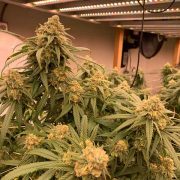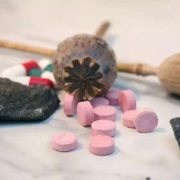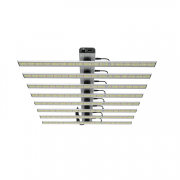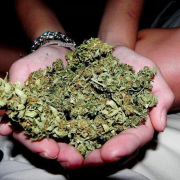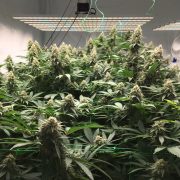Newest LED Grow Lights Buyers Guide
How To Choose THE Best LED Grow Lights For Indoor Plants?
There was a time when choosing a grow light was simple – all you needed to know was what brand and wattage you wanted. Things have changed. Drastically. The market has been flooded with grow light options and it can be quite challenging to figure out which light is best for you.
If you are new to growing cannabis indoors, it may overwhelm you to see how many different LED grow lights are on the market today. Things such as light spectrum, wattage, and PAR output leave many to wonder what’s actually important. What should you really be looking for when buying a LED grow light and where do you begin? This article will go over the different things you should consider when shopping for a LED grow light.

Coverage Area & Light Distance
First, you need to know the size of the grow space that your plants will be growing in. Measure your grow space – length, width, and height. Knowing what size grow area you will be growing in is arguably the most important piece of information to know when shopping for a LED grow light. A LED grows light manufacturer will design their grow light for a specific coverage area. The most common coverage areas are 2’x2’, 2’x4’, 3’x3’, 4’x4’, and 5’x5’. As you can see, the length and width are mentioned, but not the height. Hang tight. We will talk about the height of your grow space in a minute. Once you measure your grow space and know what area you need your LED grow light to cover, you can narrow down your search results by filtering to show LED grow lights specific to your grow space.
Now, what about the height of your grow space? That comes into play when we talk about light distance. Every grows light listing should state the coverage area as well as the recommended light distance. The light distance is the distance between the grow light and the top of your plants. Light distance is another thing you need to consider when buying a LED grow light. I’ve had several growers contact me asking for advice on plants that grew too close to their grow light – because they did not factor in the light distance when buying their LED grow light. Let’s go over a quick example. Say your grow space is 4’x4’x6’ (L x W x H) and the recommended light distance on your LED grow light is 24”. So, 6’ (height of grow space) minus 2’ (light distance) equals 4’ tall plants? Right? Wrong! You should also consider the grow pot (which often takes up about 12” depending on the grow pot size) and the “lost distance” above the grow lights which is taken up by the grow light hanging kit.
Photon efficacy
Photon efficacy refers to how efficient a grow light is at converting electrical energy into photons of PAR. On grow light listings, you’ll see it as umol/j. The higher this number is, the more efficient the grow light is at converting electrical energy into photons of PAR.
The industry standard for measuring grow light efficiency is micromole per joule (sometimes written as umol/j, μmol/j, μmolj-1, or PPF/W). That means that for every joule of electrical energy (joule = watt * second) a certain number of photon micromoles are produced. One micromole = 602,000,000,000,000,000. That’s a dizzyingly large amount of photons!
In 2020, a photon efficacy of 2.0 umol/j or higher is considered very efficient. Highly efficient LED grow light ranges from 1.5 μmol/j and up (this number is constantly improving). Many of the most efficient LED grow lights are low power and, as a buyer, you may have to weigh out whether you are looking for efficiency or intensity because at times one can be at the sacrifice of the other. Top brand HPS (high-pressure sodium) lights are around 1.7 μmol/j.
Wall Plug Efficiency
Another measurement relevant to DIY LED grow light enthusiasts is wall-plug efficiency (WPE). This is a ratio of the amount of energy put in and the amount of light produced. This can be expressed as a percentage, such as 60% “wall-plug efficiency,” which means that 60% of the electricity that goes through the light gets converted into light. The rest gets turned into heat that will need to be dealt with in the grow light itself as well as the room that houses the light.
It’s not typical to rate a grow light’s wall-plug efficiency, but high-quality diodes made specifically for horticulture occasionally have this listed. For instance, high-quality blue LEDs at 450nm can reach wall plug efficiencies of 60%, red LEDs at 660nm with 50% WPE, and green 530nm with 25% WPE. Wall plug efficiency can be calculated using a diode’s radiant flux (not luminous flux, which is a measure of how bright a light appears to the human eye and not how many photons it is producing) divided by the total wattage of electricity the diode uses. Remember to convert between milliwatt and watt, as necessary (1000 milliwatts = 1 watt).
Achieving High Efficiency
Brands increase their efficiency by having high-quality diodes, running them at low energy, having excellent heat management, and using a high percentage of the most efficient diode wavelengths. While some LED companies market themselves as having many different color LEDs, this can often be at sacrificed efficiency, since each color of LED has a different efficiency at producing light. For instance, 450nm, 660nm, and high kelvin white (white LEDs are 450nm with a phosphor coating) are very efficient, while green LEDs are not very efficient.
Intensity
While there is no doubt that grows light spectrum is important, some studies suggest that even more important than spectrum is light intensity. There are a number of ways of measuring the intensity of a grow light – some good and others bad.
Some of you may be wondering about the LED grow lights that produce over 900 PPFD. Will a PPFD higher than 900 produce bigger buds on your plant? The answer to that is yes – only if you run a high CO2 in your grow environment. CO2 is measured by PPM and the CO2 level outside is 400-500 PPM. Plants grow just fine with that amount of CO2. Some advanced growers will add CO2 into their grow room to get the CO2 PPM in the range of 1,000-1,500. Running a higher CO2 PPM like that will allow your plant to absorb more PAR. On the flip side, if you are not supplementing with CO2 and provide your plant with too much PAR, then your plant could encounter problems.
Many manufacturers list wattage (watts) as a metric to describe the light intensity. However, watts are a measure of electrical consumption and not light output. I will talk more about watts later in this article but wanted to quickly mention it here in the PAR section since it’s often confused with it. Many people assume that the higher the watts means the higher intensity. That is certainly not true. Also, lumens, LUX, and foot candles are other metrics that some grow light manufacturers use to describe the intensity. These are outdated metrics. When you measure light intensity using LUX or foot candles, blue and red light are underrepresented and therefore, you are not getting an accurate measurement of PAR. If a grow light listing lists the watts, lumens, LUX, or foot candles to represent intensity instead of PPF, PPFD, or Photon Efficacy, be cautious!
Wattage
This is the most common measure of grow light intensity and is a measure of electricity (watt = amp x volt). This measure can be misleading, though. Some manufacturers (the better ones) give the actual wattage the unit uses – the wall plug wattage. Others, typically lesser brands, will give you the max wattage rating of the LED diodes. To use a simple example, a grow light could call itself 90 watts if it has thirty 3 watt LED’s, however, it is common practice to run LED’s at half wattage to reduce heat production (and therefore heatsink cost) and increase efficiency. So, what was called a 90w grow light could really be 45w (or less!).
Bottom line, you want an actual power draw, not an LED wattage rating. It can be good to be suspicious of overly round numbers – you are likely getting the diode rating and not the actual power draw. Knowing the wattage of the diodes isn’t useless, though. You will get a heck of a lot more light out of a 3-watt diode run at 1 watt than a 1-watt diode run at 1 watt.
PPF
PPF (Photosynthetic Photon Flux) measures the total amount of light produced by a grow light in terms of micromoles of photons produced per second (often written as umol/s or μmol/s). This is an important number because unlike PPFD (which will be explained below) it can’t be manipulated and tells you the full amount of light coming from the LED grow light.
PPFD
PPFD (Photosynthetic Photon Flux Density) measures the number of micromoles of photons striking a square meter per second (often written as μmol/m2/s, μmol/m2/s, or μmolm-2s-1).
Full daylight sun at noon in the summer is around 2000 μmol/m2/s. What your plants actually need, however, is likely to be much less than that. In fact, because the Sun’s intensity is only that bright for a small portion of the day and because the angle of that intensity changes throughout the day, providing that much light for an extended period of time would very likely be damaging to your plant. A ‘light response curve’ shows how effectively a plant utilizes light at differing intensities. Depending on the plant, at levels greater than 800-1000 μmol/m2/s the efficiency that a plant uses the light starts to slow. Meaning, you can provide your plant more light than this, but you might not see a huge change in outcome.
It’s worth noting that some LED companies can increase their PPFD numbers by measuring extremely close to the grow light or using spot-light like reflectors or lenses. An LED company should always report what distance their PPFD numbers were taken at (e.g., 24 in, etc.).
PAR
This is not a measurement at all, but instead, a type of light that can be absorbed by plants (and coincidentally seen by humans). It ranges from 400 to 700nm.
Lumens
This is a measure of the total apparent brightness of a light source and not how many photons are produced. As the cliche goes, “lumens are for humans.” You can think of it as the brightness of a single candle (although the real definition is more complex). By in large, lumens are not a useful measure of light intensity for plants since they overweight colors like green and underweight reds and blues. For instance, 1W of radiant flux at 550nm (green, which the human eye is very sensitive to) is 675 lumens. One watt of radiant flux at 660nm (deep red) is only 45 lumens. The red light will be more easily absorbed by your plant in photosynthesis than the green one, but your eye will see the green light as 15 times brighter than the red light!
Lux/Footcandle
This measures how much brightness is striking a unit of area. Contrast this with lumen which is the total amount of brightness coming from the light source in all directions. Lux = one lumen per meter squared. Footcandle = one lumen per foot squared.
- Seedlings, clones, mother plants: 200-400 PPFD
- Early to late Veg: 400-600 PPFD
- Flowering: 600-900 PPFD
Some of you may be wondering about the LED grow lights that produce over 900 PPFD. Will a PPFD higher than 900 produce bigger buds on your plant? The answer to that is yes – only if you run a high CO2 in your grow environment. CO2 is measured by PPM and the CO2 level outside is 400-500 PPM. Plants grow just fine with that amount of CO2. Some advanced growers will add CO2 into their grow room to get the CO2 PPM in the range of 1,000-1,500. Running a higher CO2 PPM like that will allow your plant to absorb more PAR. On the flip side, if you are not supplementing with CO2 and provide your plant with too much PAR, then your plant could encounter problems.

Spectrum
The light spectrum is another thing that should be considered when purchasing a LED grow light.
The spectrum is essentially the colors of light that are emitted from the grow light. Different colors are made by photons at certain energy levels and are broken down into nanometers (nm).
The differences in the nm of a photon, or its color, change its potential effectiveness to drive photosynthesis. When growing cannabis, the plant uses more blue light when in the vegetation stage and then switches to use more red light when in the flowering stage. Although blue light and red light are needed most, cannabis plants also need other colors in the PAR range (400-700nm). UV (ultraviolet) light and IR (infrared radiation) light are also needed – in smaller amounts. See the below images for grow light spectrum examples. If a grow light listing does not show the spectrum, ask the manufacturer. I’ve spoken with many new growers who have purchased a LED grow light without factoring in the spectrum, and unfortunately, it just about always led to poor plant growth.
When choosing a spectrum of light for growing plants, two main factors should be weighed:
- Photosynthesis – You need to choose a light that caters to the energy production of your plants. The McCree curve and absorption peaks of photopigments are worth researching to learn more about this.
- Photomorphogenesis – ‘Photo’ means ‘light’, ‘morpho’ means ‘shape,’ ‘genesis’ can be translated as ‘creation of.’ So, it’s using light to create a certain plant shape. Light can do a lot more than just change the growth pattern of a plant, though. It can trigger or delay flowering and fruiting, change chemical composition, among other diverse reactions.
Spectral terms relevant for white LEDs:
CRI
CRI (color rendering index) describes how “full-spectrum” a light is and is typically only used for white LEDs. This scale maxes out at 100. “High CRI” means that light is producing an abundance of each color within the visible spectrum and therefore “renders” objects illuminated by the light as the color that they would appear under full daylight (which is 100 CRI). High CRI may sound more appealing, but there are instances where low CRI can be more desirable since low CRI phosphors can be more efficient at producing light and run cooler. What “high CRI” typically translates to is more red and cyan than “low CRI.” Not all light is created equal.
CCT
CCT (correlated color temperature) is a measure of how “warm” or “cool” a light source appears. The scale represents the appearance of a glowing object at different temperatures, measured in the temperature scale of Kelvin (a scale commonly used in physics and chemistry, abbreviated as ‘K’). For instance, if you were to place an iron rod within a furnace and heat it to 2700K its glow would have the same appearance as a 2700K lamp. Higher Kelvin lights produce more blue and lower Kelvin lights produce more yellow, orange, and red.

Light Spread
Light spread often referred to as uniformity, is another thing to consider when searching for your LED grow light. Don’t buy a LED grow light where the light is heavily focused in the middle of the grow space. That is how a lot of the older grow lights were designed. Ideally, the PAR coming from your grow light is evenly distributed onto your grow space. Think about it. If you have 8 branches on your plant, you wouldn’t want 4 of the branches getting 800 PAR and the other 4 branches getting 200 PAR. That makes no sense. You want all of the branches to get an even amount of PAR. This will theoretically result in even, healthy growth across the entire plant. Although, grow light technology isn’t yet to the point where fixtures are able to evenly distribute the light so that every square inch of the coverage area is receiving the same amount of PAR – but it has improved tremendously over the years. Light spread can be seen by looking at the grow light’s PAR chart. PAR charts show the amount of PAR at a specific spot. Remember PPFD?
Just like the other things that we’ve covered in this article, if the grow light listing doesn’t show a PAR chart, be cautious!

Diodes
The diodes on a grow light can certainly have a large impact on the fixture’s performance. The process to create and sort diodes is actually pretty interesting. Each diode made in a given production run will exhibit tiny variances from the others in its batch, despite the fact that they were all created with the same materials. For this reason, manufacturers sort newly created diodes through a classification process that groups together like diodes. This process is called binning. The criteria manufacturers use to bin their diodes are color wavelength and forward voltage. These two metrics measure the specific color profile and brightness levels of a given diode. Each diode manufacturer has its own binning process and “Top Bin” diodes are the best diodes out of the batch produced. The best diode manufacturers here in 2020 are CREE, OSRAM, and Samsung. Many growers will only buy a LED grow light with diodes from those manufacturers since they are well-known for their exceptional quality.
Footprint/Form Factor/Lenses/Reflectors
One of the many significant advantages of LEDs is that they offer greater control in light concentration and directionality. As growers, we need to care about providing light to as much of our plants as possible to increase whole-plant photosynthesis. There are two ways that achieve that and which you choose will depend on your particular situation and crop.
The first way to get light deep into your canopy is to have a very concentrated light beam. This is achieved by tightly packing your diodes together and by using reflectors and lenses to direct the light. The other way, which may seem initially counterintuitive, is to provide multiple sources of very diffuse light. By allowing the light to be cast at many angles on the plant, deep canopy penetration can also be achieved.
These different approaches, or some compromise in between, all affect how much area your grow light can effectively cover – its footprint. Make sure that you have measured your grow space and that the lights you are looking at can properly cover that area.
Other
A few other things to consider are drivers and warranty. A grow light with a low-quality driver could become faulty and have to be replaced. Therefore, many growers target ‘Inventronics’ drivers since they are a manufacturer well-known for their quality. I highly recommend you get a LED to grow light with quality components so it will last you several years. For added protection, go with a LED grow light that has a long warranty. The best LED grow light manufacturers here in 2020 offer at minimum, a 3-year warranty. Some even offer a 5-year warranty. If the company offers a shorter warranty, such as a 1-year, consider buying a different grow light that offers you greater protection in case a defect were to occur. Buy from a company that stands by their product and will guarantee that it will work for years to come.

Thermal Management
The cooler an LED stays the longer it will last and the higher its efficiency will be. Most LED manufacturers recommend operating temperatures below 850C (1850F). To achieve this, there are two broad categories of heat management:
- Active cooling – As the name implies, this involves expending energy to reduce a light’s temperature. Fans blowing over a heat sink is the most common method. Liquid cooling is another method that due to the high heat capacity of water has gained an avid following within the computing and lighting community. It’s also how your car’s engine cools! Quality manufacturers have safeguards put into place that, in the unlikely event of a malfunction, protect the LEDs from overheating and turn off the light.
- Passive cooling – This method doesn’t require energy to cool but can have higher upfront costs and heavier final product weight. Factors that go into a high-quality heatsink include material (e.g., aluminum), shape (e.g., pin fin), anodization, and production process (e.g., extrusion, cold forging, etc.).
Total Cost of Ownership
If you plan on using your light for a while, LEDs are a better deal than HID. High-end LED grow lights are more efficient than HID and have far more ability to provide a specific, tailored spectrum. Lower energy consumption is not only good for you, but it’s good for the environment. Don’t forget, too, the cost and hassle associated with changing bulbs for HID fixtures every year to six months. A good LED grows light will last you many years, maintenance-free. If that wasn’t enough, you also don’t have to feel guilty about using a light that contains mercury and other toxic heavy metals like those contained in HID and fluorescent.

Conclusion
There are many things to consider when purchasing a LED grow light. The coverage area and light distance will help narrow down your search results and ensure your grow space is appropriately covered. PAR output is measured in different ways and misinformation about intensity is very common. The light spectrum that the LED grows light emits is important since cannabis has different needs throughout its life. Also, an even light spread will help with growth across the entire plant. Wattage is often confused for light intensity instead of what it actually is – energy consumption. It’s better to go with high-quality diodes and efficient drivers from trusted manufacturers instead of going with unknown brands. Lastly, the warranty that the LED grows light has will offer you protection in case the light becomes defective. Considering these things prior to buying a LED grow light will help ensure your money is being well spent.
How to Grow Cannabis(Marijuana)? Where Is Cannabis(Marijuana) Legal?
Where to buy a Super High-yield Cannabis Plants Grow Light?




